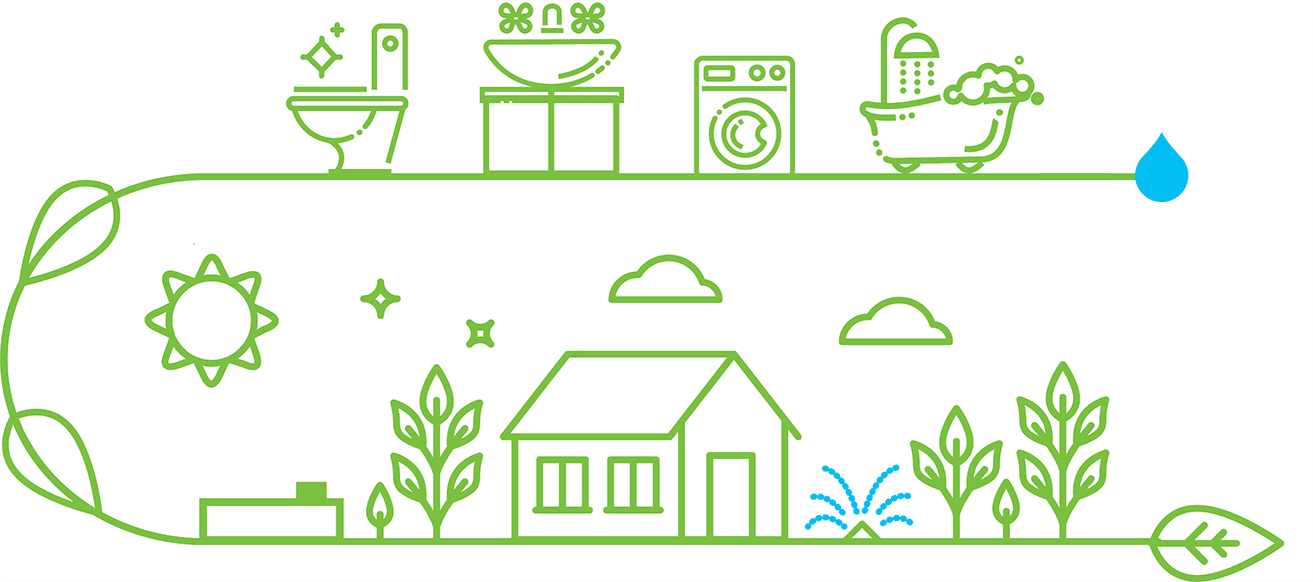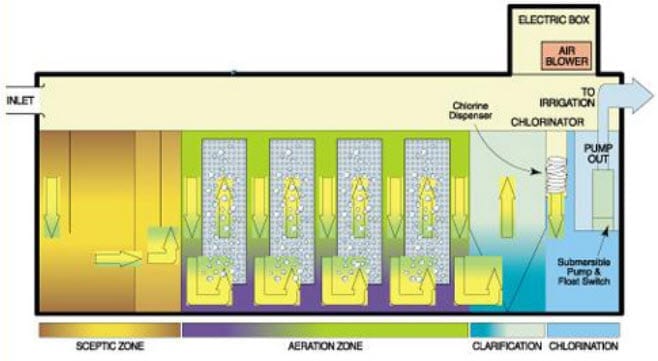The post Home Sewage Treatment Plant (HSTP), What Are They? appeared first on Garden Master.
Guide: Home Sewage Treatment Plant (HSTP)
A Home Sewage Treatment Plant, also known as an HSTP or Onsite Sewage Management System, is a decentralised wastewater treatment system designed for residential homes, small communities or small commercial sites that are not connected to centralised sewer systems.
The primary purpose of an HSTP is to treat and purify domestic wastewater generated in a home or small community so that it can be safely discharged into the environment without causing harm.
Regulations for HSTPs can vary by location and local council requirements, so it’s essential to know your local guidelines and standards when installing or maintaining these systems.
The HSTP receives and treats all household wastewater from the following:
toilet bathroom kitchen laundry
A Home Sewage Treatment Plant (HSTP) receives all wastewater (both greywater and blackwater) from the premises, including the kitchen, toilet, shower and laundry, and quietly and efficiently recycles all your household wastewater into clean, clear and odourless water suitable for irrigation in your garden and lawns.
This Is How A Typical HSTP Works:

HSTPs usually comprise multiple treatment stages, including primary settling, aeration, clarification, and disinfection, treating wastewater by breaking down organic matter and reducing harmful contaminants before the treated water is discharged into the environment or dispersed via subsurface irrigation.
Home Sewage Treatment Plant Pros & Cons
Home Sewage Treatment Plants (HSTPs) offer several advantages and disadvantages, depending on your specific needs and circumstances. Here are the pros and cons of using HSTPs:
HSTP Pros:
Environmental Benefits: Water Recycling: HSTPs treat wastewater onsite, which can be used for irrigation, reducing the demand on local water sources. Reduced Pollution: Properly functioning HSTPs prevent the contamination of nearby groundwater and surface water bodies, contributing to environmental conservation. Independence: No Connection Costs: You don’t need to pay for connecting to a centralised sewer system, which can be expensive. Location Flexibility: HSTPs are suitable for rural or remote areas where centralised systems are not feasible. Cost Savings: Lower Water Bills: By recycling treated wastewater for irrigation, you can reduce water consumption and save on water bills. Avoid Monthly Fees: You don’t have to pay ongoing fees to a sewer utility. Reliability: Less Vulnerable: HSTPs are less susceptible to damage during natural disasters that might affect centralised sewer systems.HSTP Cons:
Upfront Costs: Installation Costs: Setting up an HSTP can be expensive, including the cost of tanks, pipes, irrigation and treatment equipment. Maintenance Costs: Routine maintenance and occasional repairs can add to the long-term cost. Ongoing Maintenance: Regular Servicing: HSTPs require routine maintenance, including inspections, pumping, and cleaning to ensure proper function. Environmental Risks: Inadequate maintenance can lead to system failures and environmental contamination. Regulations and Permits: Varied Regulations: Local regulations and permits can be complex, with different requirements for HSTPs depending on your location. Compliance Challenges: Meeting and maintaining compliance can be a challenge. Limited Capacity: Sizing: The capacity of an HSTP is typically designed for a specific number of occupants and may not be easily expandable. Effluent Quality: Variable Quality: The quality of effluent from HSTPs can vary. Some systems might not be suitable for water reuse. Odor and Noise: Potential Odours: Some HSTPs can emit odours, especially if not adequately maintained. Noise: Aeration systems in certain HSTPs can generate noise. Energy Use: Electricity Consumption: HSTPs with mechanical components, like pumps and aerators, can consume electricity.The decision to install an HSTP should be made considering your specific location, local regulations, budget, and your commitment to regular maintenance. If properly designed, installed, and maintained, HSTPs can be environmentally friendly and cost-effective for managing wastewater in areas without access to centralised sewer systems.
Buying a HSTP
Before purchasing a Home Sewage Treatment Plant (HSTP) system, there are several important factors to consider to ensure you make the right choice for your property and needs. Here are some key considerations:
Regulations and Permits: Check local, state, and national regulations governing the use of HSTP systems. Ensure you have the necessary permits and approvals to install and operate such a system on your property.We recommend reading: Septic Tank Regulations In NSW
Site Suitability: Assess your property to determine if it suits an HSTP. Factors like soil type, available space, and groundwater conditions can affect the system’s performance. System Size: The size of the HSTP should match the wastewater generation of your household or facility. Consider the number of occupants, daily water usage, and peak flow rates when sizing the system. Treatment Capacity: Evaluate the treatment capacity of the HSTP. It should be capable of treating your wastewater to meet local discharge or reuse standards. Local Climate: Consider the local climate conditions. Extremely hot or cold climates may require additional insulation, heating, or cooling for the system to operate effectively. Maintenance Requirements: Different HSTP systems have varying maintenance needs. Understand what is required for upkeep and whether you can manage these tasks or need professional servicing. Energy Consumption: Determine the energy requirements of the system. Some HSTP systems are energy-efficient, while others may consume more power—factoring in ongoing operational costs. Quality of Effluent: Assess the quality of the treated effluent. It should meet environmental standards for safe discharge or reuse, especially if you plan to use the effluent for irrigation. System Brand and Model: Research reputable manufacturers and models. Choose a system with a good track record and consider factors like reliability, warranty, and availability of spare parts. Local Service Providers: Ensure local professionals are available for system installation and maintenance. Prompt service is essential to keep the HSTP running smoothly. Budget: Set a budget for the purchase, installation, and ongoing maintenance of the HSTP. Remember to factor in long-term operational costs. Environmental Impact: Consider the environmental impact of your HSTP. The system should treat wastewater in an eco-friendly manner and prevent groundwater contamination. Long-Term Plans: Think about your long-term plans for the property. If you intend to expand or make changes, consider how the HSTP will fit into your future plans. Consult a Professional: It’s advisable to consult with a wastewater specialist or engineer who can assess your property and help you select the most suitable HSTP system. Warranty and Support: Inquire about the manufacturer’s warranty and the availability of customer support in case of issues. References: Ask for references from property owners who have installed similar HSTP systems to learn from their experiences.Considerations When Choosing a Septic System
We highly recommend reading our Septic Tank Buying Guide, which covers all the primary considerations. Such as:
Set back distances from houses, structures, waters sources etc Types of Septic Tanks and Systems The average cost of a septic system The process of getting a quote through to the installationSpeaking with an industry professional is an excellent idea to help you choose the best septic system tailored to your site.
Why are Garden Master HSTP good?

For over 30 years, we have provided reliable Home Sewage Treatment Plants, Septic Tanks, Aerated Wastewater Treatment Systems (AWTS) and Advanced Secondary Treatment Systems (STS) for domestic and commercial installations.
The team at Garden Master are experts in the design, supply and installation of top-quality wastewater systems. Our residential septic systems and commercial wastewater management systems are approved by the NSW, VIC and ACT departments of health.
Our main HSTP is the Garden Master “Elite” Advanced Secondary Treatment System. The Garden Master “Elite” Advanced STS (Secondary Treatment System) is an Aerated Wastewater Treatment System and comes in a single concrete septic tank with 7100L capacity for domestic premises with up to 10 people or a dual tank option for commercial sites with a capacity of up to 20 people.
Our Septic Tanks are proudly Australian-made and manufactured at our factory to ensure that our exacting standards are being met.
The Garden Master advanced secondary treatment system (STS) has been designed to treat the effluent to achieve the best possible quality water before discharge back into the environment.
Garden Master has been an industry leader for over 30 years, manufacturing, supplying, and servicing quality wastewater treatment systems and septic tanks for thousands of clients across Australia.
Don’t hesitate to call us on 1800 632 582 with any questions!
The post Home Sewage Treatment Plant (HSTP), What Are They? appeared first on Garden Master.


